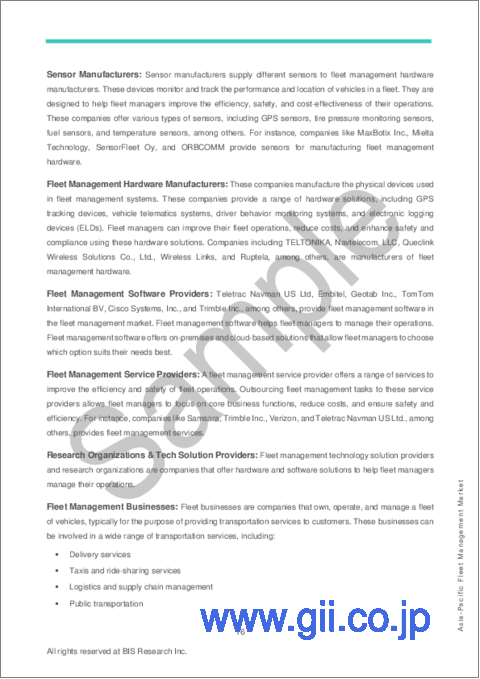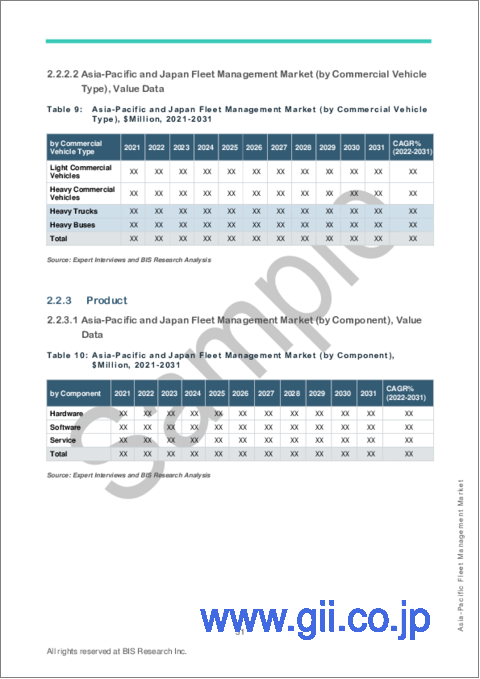|
|
市場調査レポート
商品コード
1395422
アジア太平洋のフリートマネジメント市場 - 分析と予測(2022年~2031年)Asia-Pacific Fleet Management Market - Analysis and Forecast, 2022-2031 |
||||||
カスタマイズ可能
|
|||||||
| アジア太平洋のフリートマネジメント市場 - 分析と予測(2022年~2031年) |
|
出版日: 2023年12月14日
発行: BIS Research
ページ情報: 英文 86 Pages
納期: 1~5営業日
|
- 全表示
- 概要
- 図表
- 目次
アジア太平洋のフリートマネジメントの市場規模は、2022年の3億4,000万米ドルから2031年には24億3,000万米ドルに達し、予測期間の2022年~2031年のCAGRは24.45%になると予測されています。
予測期間中、技術の進歩が商用車フリートマネジメントツールの成長を加速させています。コネクテッドカーの登場により、市場開拓活動が大きく促進されると予測されます。
| 主要市場統計 | |
|---|---|
| 予測期間 | 2022年~2031年 |
| 2022年評価額 | 3億4,000万米ドル |
| 2031年予測 | 24億3,000万米ドル |
| CAGR | 24.45% |
アジア太平洋の車両管理市場は大きく拡大しています。これらのシステムが商用車部門にもたらす利点に対する認識の高まりが、車両管理市場の成長を後押ししています。さらに、産業革命による新技術の採用が、APAC市場における車両管理市場の成長につながっています。
アジア太平洋の車両管理産業は、商用車管理技術の技術的進歩により大きく進化しています。予測期間を通じて、これらのツールは急成長すると予想され、リンクされた車の普及が重要な市場開拓の取り組みを大きく後押しすると予想されます。最先端の管理システムが提供する多くの利点に対するフリート企業の認識が高まっているため、アジア太平洋のフリートマネジメント業界は現在拡大しています。このような意識の高まりは、市場の成長を後押しする主な要因の1つであり、産業革命の進行やAPAC商用車業界の最先端技術の利用拡大も後押ししています。
当レポートでは、アジア太平洋のフリートマネジメント市場について調査し、市場の概要とともに、応用タイプ別、車両タイプ別、コンポーネント別、展開別、国別の動向、および市場に参入する企業のプロファイルなどを提供しています。
目次
エグゼクティブサマリー
調査範囲
第1章 市場
- 市場の見通し
- ビジネスダイナミクス
第2章 地域
- 中国
- アジア太平洋と日本
第3章 市場-競合ベンチマーキングと企業プロファイル
- 競合ベンチマーキング
- 市場シェア分析
- 企業プロファイル
- Embitel
- Queclink Wireless Solutions Co., Ltd
- スタートアップ企業のスナップショット
- Fleetx
- Wonder Wagen
第4章 調査手法
List of Figures
- Figure 1: Fleet Management Market, $Million, 2021-2031
- Figure 2: Fleet Management Market (by Deployment), $Million, 2021-2031
- Figure 3: Fleet Management Market (by Commercial Vehicle Type), $Million, 2022, 2026, and 2031
- Figure 4: Fleet Management Market (by Component), $Million, 2021-2031
- Figure 5: Fleet Management Market (by Application Type), $Million, 2021-2031
- Figure 6: Fleet Management Market (by Region), 2021
- Figure 7: List of Key Players Included in the Fleet Management Market Report
- Figure 8: Supply Chain Analysis for the Fleet Management Market
- Figure 9: Stakeholders in Fleet Management Market
- Figure 10: Fleet Management Process
- Figure 11: Business Dynamics for Fleet Management Market
- Figure 12: Fleet Management Market: Impact of Business Drivers
- Figure 13: OPEC Basket Price (2016-2022)
- Figure 14: Fleet Management Market: Impact of Business Challenges
- Figure 15: Share of Key Business Strategies (2019-2023)
- Figure 16: Share of Product Developments (by Company), 2019-2023
- Figure 17: Share of Key Corporate Strategies (2019-2023)
- Figure 18: Share of Mergers and Acquisitions (by Company), 2019-2023
- Figure 19: Share of Partnerships, Joint Ventures, Collaborations, and Alliances(by Company), 2019-2023
- Figure 20: Fleet Management Market: Impact of Business Opportunities
- Figure 21: Competitive Benchmarking in China, 2021
- Figure 22: Competitive Benchmarking in Asia-Pacific and Japan, 2021
- Figure 23: Competitive Benchmarking in Fleet Management Market, 2021
- Figure 24: Research Methodology
- Figure 25: Data Triangulation
- Figure 26: Top-Down and Bottom-Up Approach
- Figure 27: Assumptions and Limitations
List of Tables
- Table 1: Fleet Management Market Overview
- Table 2: Key Patents Mapping
- Table 3: Fleet Management Market (by Region), $Billion, 2021-2031
- Table 4: China Fleet Management Market (by Application Type), $Million, 2021-2031
- Table 5: China Fleet Management Market (by Commercial Vehicle Type), $Million, 2021-2031
- Table 6: China Fleet Management Market (by Component), $Million, 2021-2031
- Table 7: China Fleet Management Market (by Deployment), $Million, 2021-2031
- Table 8: Asia-Pacific and Japan Fleet Management Market (by Application Type), $Million, 2021-2031
- Table 9: Asia-Pacific and Japan Fleet Management Market (by Commercial Vehicle Type), $Million, 2021-2031
- Table 10: Asia-Pacific and Japan Fleet Management Market (by Component), $Million, 2021-2031
- Table 11: Asia-Pacific and Japan Fleet Management Market (by Deployment), $Million, 2021-2031
- Table 12: Japan Fleet Management Market (by Application Type), $Million, 2021-2031
- Table 13: Japan Fleet Management Market (by Commercial Vehicle Type), $Million, 2021-2031
- Table 14: Japan Fleet Management Market (by Component), $Million, 2021-2031
- Table 15: Japan Fleet Management Market (by Deployment), $Million, 2021-2031
- Table 16: India Fleet Management Market (by Application Type), $Million, 2021-2031
- Table 17: India Fleet Management Market (by Commercial Vehicle Type), $Million, 2021-2031
- Table 18: India Fleet Management Market (by Component), $Million, 2021-2031
- Table 19: India Fleet Management Market (by Deployment), $Million, 2021-2031
- Table 20: South Korea Fleet Management Market (by Application Type), $Million, 2021-2031
- Table 21: South Korea Fleet Management Market (by Commercial Vehicle Type), $Million, 2021-2031
- Table 22: South Korea Fleet Management Market (by Component), $Million, 2021-2031
- Table 23: South Korea Fleet Management Market (by Deployment), $Million, 2021-2031
- Table 24: Rest-of-Asia-Pacific and Japan Fleet Management Market (by Application Type), $Million, 2021-2031
- Table 25: Rest-of-Asia-Pacific and Japan Fleet Management Market (by Commercial Vehicle Type), $Million, 2021-2031
- Table 26: Rest-of-Asia-Pacific and Japan Fleet Management Market (by Component), $Million, 2021-2031
- Table 27: Rest-of-Asia-Pacific and Japan Fleet Management Market (by Deployment), $Million, 2021-2031
- Table 28: Market Share Analysis, 2021
- Table 29: Embitel: Product Portfolio
- Table 30: Embitel: Partnerships, Collaborations, Investments, Mergers, and Acquisitions
- Table 31: Queclink Wireless Solutions Co., Ltd.: Product Portfolio
- Table 32: Queclink Wireless Solutions Co., Ltd.: Partnerships, Collaborations, Investments, Mergers, and Acquisitions
- Table 33: Fleetx: Product Portfolio
- Table 34: Wonder Wagen: Product Portfolio
“The Asia-Pacific Fleet Management Market (excluding China) Expected to Reach $2.43 Billion by 2031.”
Introduction to Asia-Pacific (APAC) Fleet Management Market
The Asia-Pacific fleet management market is projected to reach $2.43 billion by 2031 from $0.34 billion in 2022, growing at a CAGR of 24.45% during the forecast period 2022-2031. Technological advancements are driving an accelerated growth in commercial vehicle fleet management tools over the predicted period. It is projected that significant market development activities will be enhanced by the advent of connected vehicles.
| KEY MARKET STATISTICS | |
|---|---|
| Forecast Period | 2022 - 2031 |
| 2022 Evaluation | $0.34 Billion |
| 2031 Forecast | $2.43 Billion |
| CAGR | 24.45% |
The fleet management market in Asia-Pacific is expanding significantly. Growing awareness of the advantages these systems offer the commercial vehicle sector is driving the growth of the fleet management market. Furthermore, the adoption of new technologies by the industrial revolution has led to a growth in fleet management in the APAC market.
Market Introduction
The APAC fleet management industry is evolving significantly due to technological advancements in commercial vehicle management technologies. Throughout the course of the forecast period, these tools are anticipated to grow fast, and the widespread usage of linked cars is anticipated to greatly boost crucial market development efforts. Due to fleet firms' increasing awareness of the many benefits offered by state-of-the-art management systems, the APAC fleet management industry is now expanding. This greater awareness is one of the primary factors propelling the market's growth, which is also being helped by the ongoing industrial revolution and the APAC commercial vehicle industry's growing use of cutting-edge technologies.
Market Segmentation:
Segmentation 1: by Application Type
- Real Time Location Monitoring
- Fuel Management
- Maintenance Management
- Driver Management
- Weight/Volume Tracking
- Accounting and Insurance
Segmentation 2: by Vehicle Type
- Light Commercial Vehicles
- Heavy Commercial Vehicles
Segmentation 3: by Component
- Hardware
- Software
- Service
Segmentation 4: by Deployment
- On-Premises
- Cloud
Segmentation 5: by Country
- Japan
- South Korea
- India
- Rest-of-Asia-Pacific and Japan"
How can this report add value to an organization?
Product/Innovation Strategy: The product segment helps the reader understand the different types of fleet management products available by Component (Hardware, Software, and Service), by Deployment (On-Premises and Cloud), by Application Type (Real Time Location Monitoring, Fuel Management, Maintenance Management, Driver Management, Weight/Volume Tracking, and Accounting and Insurance), by Commercial Vehicle Type (Light Commercial Vehicles and Heavy Commercial Vehicles). Increasing demand worldwide is pushing the sales of fleet management systems. Therefore, the fleet management business is a low-investment and high-revenue generating model.
Growth/Marketing Strategy: The APAC Fleet Management Market is exponentially growing, with enormous opportunities for the market players. Some strategies covered in this segment are product launches, partnerships and collaborations, business expansions, and investments. The companies' preferred strategy has been product launches, partnerships, and collaborations to strengthen their positions in the APAC fleet management market.
Competitive Strategy: Key players in the APAC fleet management market analyzed and profiled in the study involve fleet management-based product manufacturers and start-ups. Moreover, a detailed competitive benchmarking of the players operating in the APAC fleet management market has been done to help the reader understand how players stack against each other, presenting a clear market landscape. Additionally, comprehensive competitive strategies such as partnerships, agreements, and collaborations will aid the reader in understanding the untapped revenue pockets in the market.
Key Market Players and Competition Synopsis
The companies that are profiled have been selected based on inputs gathered from primary experts and analysing company coverage, product portfolio, and market penetration.
Some of the prominent names established in this market are:
|
|
Table of Contents
Executive Summary
Scope of the Study
1. Markets
- 1.1. Market Outlook
- 1.1.1. Fleet Management Trends
- 1.1.1.1. Successful Transport Companies Becoming Increasingly Data-Driven
- 1.1.1.2. Moving Toward Privately Owned Vehicles
- 1.1.1.3. Uncertain Fuel Costs
- 1.1.1.4. Keeping Fleets Relevant Requires the Adoption of Electric Vehicles
- 1.1.2. Supply Chain Analysis
- 1.1.3. Key Patents Mapping
- 1.1.4. Regulatory Landscape
- 1.1.4.1. U.S. Fleet Management Laws
- 1.1.4.1.1. Vehicle Tracking Laws
- 1.1.4.1.1.1. ELD Rule
- 1.1.4.1.1.2. ELD Compliance Deadline
- 1.1.4.1.2. Impact of Fleet Management Laws on the U.S. Fleet Management Market
- 1.1.4.1.1. Vehicle Tracking Laws
- 1.1.4.2. Germany Fleet Management Laws
- 1.1.4.2.1. DGUV (German Social Accident Insurance) Regulation
- 1.1.4.2.2. Impact of Fleet Management Laws on the Germany Fleet Management Market
- 1.1.4.3. France Fleet Management Laws
- 1.1.4.3.1. WLTP Effect
- 1.1.4.3.2. Impact of Fleet Management Laws on the France Fleet Management Market
- 1.1.4.4. Australia Fleet Management Laws
- 1.1.4.4.1. Heavy Vehicle National Law
- 1.1.4.4.2. Impact of Fleet Management Laws on the Australia Fleet Management Market
- 1.1.4.1. U.S. Fleet Management Laws
- 1.1.5. Business Model
- 1.1.5.1. Subscription Model
- 1.1.1. Fleet Management Trends
- 1.2. Business Dynamics
- 1.2.1. Business Drivers
- 1.2.1.1. Growing Number of Vehicle and Asset Thefts
- 1.2.1.2. Increase in Road Accidents
- 1.2.1.3. Volatility in Fuel Prices
- 1.2.1.4. Augmented Demand for Fleet Management Solutions from Transportation and Logistics Industry
- 1.2.2. Business Challenges
- 1.2.2.1. Connecting Information Together from a Variety of Sources
- 1.2.2.2. Risk of Cyber Attacks
- 1.2.3. Business Strategies
- 1.2.3.1. Product Developments
- 1.2.3.2. Market Developments
- 1.2.4. Corporate Strategies
- 1.2.4.1. Mergers and Acquisitions
- 1.2.4.2. Partnerships, Joint Ventures, Collaborations, and Alliances
- 1.2.5. Business Opportunities
- 1.2.5.1. Surging Demand for Connected and Autonomous Vehicles
- 1.2.5.2. Emergence of the Internet of Things (IoT)
- 1.2.1. Business Drivers
2. Region
- 2.1. China
- 2.1.1. Market
- 2.1.1.1. Buyers Attributes
- 2.1.1.2. Competitive Benchmarking
- 2.1.1.3. Key Fleet Management System Providers in China
- 2.1.1.4. Business Challenges
- 2.1.1.5. Business Drivers
- 2.1.2. Application
- 2.1.2.1. China Fleet Management Market (by Application Type), Value Data
- 2.1.2.2. China Fleet Management Market (by Commercial Vehicle Type), Value Data
- 2.1.3. Product
- 2.1.3.1. China Fleet Management Market (by Component), Value Data
- 2.1.3.2. China Fleet Management Market (by Deployment), Value Data
- 2.1.1. Market
- 2.2. Asia-Pacific and Japan
- 2.2.1. Market
- 2.2.1.1. Buyers Attributes
- 2.2.1.2. Competitive Benchmarking
- 2.2.1.3. Key Fleet Management System Providers in Asia-Pacific and Japan
- 2.2.1.4. Business Challenges
- 2.2.1.5. Business Drivers
- 2.2.2. Application
- 2.2.2.1. Asia-Pacific and Japan Fleet Management Market (by Application Type), Value Data
- 2.2.2.2. Asia-Pacific and Japan Fleet Management Market (by Commercial Vehicle Type), Value Data
- 2.2.3. Product
- 2.2.3.1. Asia-Pacific and Japan Fleet Management Market (by Component), Value Data
- 2.2.3.2. Asia-Pacific and Japan Fleet Management Market (by Deployment), Value Data
- 2.2.4. Asia-Pacific and Japan (by Country)
- 2.2.4.1. Japan
- 2.2.4.1.1. Market
- 2.2.4.1.1.1. Buyers Attributes
- 2.2.4.1.1.2. Key Fleet Management System Providers in Japan
- 2.2.4.1.1.3. Business Challenges
- 2.2.4.1.1.4. Business Drivers
- 2.2.4.1.2. Application
- 2.2.4.1.2.1. Japan Fleet Management Market (by Application Type), Value Data
- 2.2.4.1.2.2. Japan Fleet Management Market (by Commercial Vehicle Type), Value Data
- 2.2.4.1.3. Product
- 2.2.4.1.3.1. Japan Fleet Management Market (by Component), Value Data
- 2.2.4.1.3.2. Japan Fleet Management Market (by Deployment), Value Data
- 2.2.4.1.1. Market
- 2.2.4.2. India
- 2.2.4.2.1. Market
- 2.2.4.2.1.1. Buyers Attributes
- 2.2.4.2.1.2. Key Fleet Management System Providers in India
- 2.2.4.2.1.3. Business Challenges
- 2.2.4.2.1.4. Business Drivers
- 2.2.4.2.2. Application
- 2.2.4.2.2.1. India Fleet Management Market (by Application Type), Value Data
- 2.2.4.2.2.2. India Fleet Management Market (by Commercial Vehicle Type), Value Data
- 2.2.4.2.3. Product
- 2.2.4.2.3.1. India Fleet Management Market (by Component), Value Data
- 2.2.4.2.3.2. India Fleet Management Market (by Deployment), Value Data
- 2.2.4.2.1. Market
- 2.2.4.3. South Korea
- 2.2.4.3.1. Market
- 2.2.4.3.1.1. Buyers Attributes
- 2.2.4.3.1.2. Key Fleet Management System Providers in South Korea
- 2.2.4.3.1.3. Business Challenges
- 2.2.4.3.1.4. Business Drivers
- 2.2.4.3.2. Application
- 2.2.4.3.2.1. South Korea Fleet Management Market (by Application Type), Value Data
- 2.2.4.3.2.2. South Korea Fleet Management Market (by Commercial Vehicle Type), Value Data
- 2.2.4.3.3. Product
- 2.2.4.3.3.1. South Korea Fleet Management Market (by Component), Value Data
- 2.2.4.3.3.2. South Korea Fleet Management Market (by Deployment), Value Data
- 2.2.4.3.1. Market
- 2.2.4.4. Rest-of-Asia-Pacific and Japan
- 2.2.4.4.1. Market
- 2.2.4.4.1.1. Buyers Attributes
- 2.2.4.4.1.2. Key Fleet Management System Providers in Rest-of-Asia-Pacific and Japan
- 2.2.4.4.1.3. Business Challenges
- 2.2.4.4.1.4. Business Drivers
- 2.2.4.4.2. Application
- 2.2.4.4.2.1. Rest-of-Asia-Pacific and Japan Fleet Management Market (by Application Type), Value Data
- 2.2.4.4.2.2. Rest-of-Asia-Pacific and Japan Fleet Management Market (by Commercial Vehicle Type), Value Data
- 2.2.4.4.3. Product
- 2.2.4.4.3.1. Rest-of-Asia-Pacific and Japan Fleet Management Market (by Component), Value Data
- 2.2.4.4.3.2. Rest-of-Asia-Pacific and Japan Fleet Management Market (by Deployment), Value Data
- 2.2.4.4.1. Market
- 2.2.4.1. Japan
- 2.2.1. Market
3. Markets - Competitive Benchmarking & Company Profiles
- 3.1. Competitive Benchmarking
- 3.2. Market Share Analysis
- 3.3. Company Profiles
- 3.3.1. Embitel
- 3.3.1.1. Company Overview
- 3.3.1.1.1. Role of Embitel in the Fleet Management Market
- 3.3.1.1.2. Product Portfolio
- 3.3.1.2. Corporate Strategies
- 3.3.1.2.1. Partnerships, Collaborations, Investments, Mergers, and Acquisitions
- 3.3.1.2.2. Production Sites
- 3.3.1.3. Analyst View
- 3.3.1.1. Company Overview
- 3.3.2. Queclink Wireless Solutions Co., Ltd.
- 3.3.2.1. Company Overview
- 3.3.2.1.1. Role of Queclink Wireless Solutions Co., Ltd. in the Fleet Management Market
- 3.3.2.1.2. Product Portfolio
- 3.3.2.2. Corporate Strategies
- 3.3.2.2.1. Partnerships, Collaborations, Investments, Mergers, and Acquisitions
- 3.3.2.3. Analyst View
- 3.3.2.1. Company Overview
- 3.3.1. Embitel
- 3.4. Start-Up Company Snapshots
- 3.4.1. Fleetx
- 3.4.1.1. Company Overview
- 3.4.1.2. Role of Fleetx in the Fleet Management Market
- 3.4.1.3. Product Portfolio
- 3.4.2. Wonder Wagen
- 3.4.2.1. Company Overview
- 3.4.2.2. Role of Wonder Wagen in the Fleet Management Market
- 3.4.2.3. Product Portfolio
- 3.4.1. Fleetx
4. Research Methodology
- 4.1. Data Sources
- 4.1.1. Primary Data Sources
- 4.1.2. Secondary Data Sources
- 4.2. Data Triangulation
- 4.3. Market Estimation and Forecast
- 4.3.1. Factors for Data Prediction and Modeling





